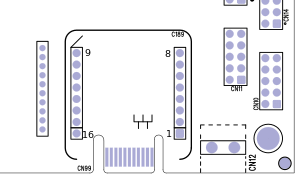TS-7250-V3 MikroBus Header: Difference between revisions
From embeddedTS Manuals
No edit summary |
No edit summary |
||
| (12 intermediate revisions by 3 users not shown) | |||
| Line 1: | Line 1: | ||
The Mikrobus header is a 0.1" pitch 2x8 header which supports [https://www.mikroe.com/click the Mikroe Click board ecosystem]. This header features 3. | The Mikrobus header is a 0.1" pitch 2x8 header which supports [https://www.mikroe.com/click the Mikroe Click board ecosystem]. This header features 3.3 V, 5 V, SPI, GPIO, ADC, PWM, a UART, and PWM. All I/O on this header are [[#IO specifications|FPGA 3.3-V LVTTL]]. | ||
The Click boards™ standard (where Click boards™ are a modular prototyping add-on board) is openly documented, [https://cdn.mikroe.com/cms/click-boards/click-board-standard-guidelines-april-2019.pdf allowing for custom boards to be designed]. | |||
By default all of these headers default to their non-gpio functions. These can be changed in the [[#FPGA Syscon|FPGA syscon register 0x08]]. For example: | |||
<source lang=bash> | |||
# Make all mikrobus header pins GPIO: | |||
peekpoke 32 0x50004008 0xF0 | |||
# Set only SPI to GPIO: | |||
peekpoke 32 0x50004008 0x10 | |||
</source> | |||
{| | {| | ||
| Line 9: | Line 20: | ||
|- | |- | ||
! Pin | ! Pin | ||
! | ! Name | ||
! Description | |||
|- | |- | ||
| 1 | | 1 | ||
| ADC | | AN | ||
| [[#FPGA_ADC]] / [[#GPIO|GPIO Chip 50004054.fpga_gpio IO 1]] <ref>This signal does not require a mux to use as a GPIO or ADC. To use the ADC signal the GPIO should be an input which is the reset default.</ref> | |||
|- | |- | ||
| 2 | | 2 | ||
| | | RST | ||
| [[#GPIO|GPIO Chip 50004054.fpga_gpio IO 0]] <ref>This signal is pulled high, but your specific click card may require a specific reset duration.</ref> | |||
|- | |- | ||
| 3 | | 3 | ||
| [[#FPGA_SPI|spidev 5.0 CS#]] | | CS | ||
| [[#FPGA_SPI|spidev 5.0 CS#]] / [[#GPIO|GPIO Chip 50004054.fpga_gpio IO 5]] | |||
|- | |- | ||
| 4 | | 4 | ||
| [[#FPGA_SPI|spidev 5.0 CLK]] | | SCK | ||
| [[#FPGA_SPI|spidev 5.0 CLK]] / [[#GPIO|GPIO Chip 50004054.fpga_gpio IO 6]] | |||
|- | |- | ||
| 5 | | 5 | ||
| [[#FPGA_SPI|spidev 5.0 MISO]] | | MISO | ||
| [[#FPGA_SPI|spidev 5.0 MISO]] / [[#GPIO|GPIO Chip 50004054.fpga_gpio IO 7]] | |||
|- | |- | ||
| 6 | | 6 | ||
| [[#FPGA_SPI|spidev 5.0 MOSI]] | | MOSI | ||
| [[#FPGA_SPI|spidev 5.0 MOSI]] / [[#GPIO|GPIO Chip 50004054.fpga_gpio IO 8]] | |||
|- | |- | ||
| 7 | | 7 | ||
| +3.3V | |||
| [[#Board Rails|3.3V]] | | [[#Board Rails|3.3V]] | ||
|- | |- | ||
| 8 | | 8 | ||
| GND | |||
| GND | | GND | ||
|- | |- | ||
| 9 | | 9 | ||
| GND | |||
| GND | | GND | ||
|- | |- | ||
| 10 | | 10 | ||
| +5V | |||
| [[#Board Rails|5V]] | | [[#Board Rails|5V]] | ||
|- | |- | ||
| 11 | | 11 | ||
| [[#I2C|/dev/i2c- | | SDA | ||
| [[#I2C|/dev/i2c-4 DAT]] / [[#GPIO|GPIO Chip 50004054.fpga_gpio IO 11]] | |||
|- | |- | ||
| 12 | | 12 | ||
| [[#I2C|/dev/i2c- | | SCL | ||
| [[#I2C|/dev/i2c-4 CLK]] / [[#GPIO|GPIO Chip 50004054.fpga_gpio IO 12]] | |||
|- | |- | ||
| 13 | | 13 | ||
| [[#UARTs| | | TX | ||
| [[#UARTs|ttyS13 TXD]] / [[#GPIO|GPIO Chip 50004054.fpga_gpio IO 9]] | |||
|- | |- | ||
| 14 | | 14 | ||
| [[#UARTs| | | RX | ||
| [[#UARTs|ttyS13 RXD]] / [[#GPIO|GPIO Chip 50004054.fpga_gpio IO 10]] | |||
|- | |- | ||
| 15 | | 15 | ||
| | | INT | ||
| [[#FPGA IRQs|FPGA IRQ 18]] / [[#GPIO|GPIO Chip 50004054.fpga_gpio IO 2]] | |||
|- | |- | ||
| 16 | | 16 | ||
| MIKRO_PWM | | PWM | ||
| [[#FPGA PWM|MIKRO_PWM]] / [[#GPIO|GPIO Chip 50004054.fpga_gpio IO 4]] | |||
|} | |} | ||
| | | | ||
Latest revision as of 10:16, 9 April 2024
The Mikrobus header is a 0.1" pitch 2x8 header which supports the Mikroe Click board ecosystem. This header features 3.3 V, 5 V, SPI, GPIO, ADC, PWM, a UART, and PWM. All I/O on this header are FPGA 3.3-V LVTTL.
The Click boards™ standard (where Click boards™ are a modular prototyping add-on board) is openly documented, allowing for custom boards to be designed.
By default all of these headers default to their non-gpio functions. These can be changed in the FPGA syscon register 0x08. For example:
# Make all mikrobus header pins GPIO:
peekpoke 32 0x50004008 0xF0
# Set only SPI to GPIO:
peekpoke 32 0x50004008 0x10
| Signals | Pin Layout | |||||||||||||||||||||||||||||||||||||||||||||||||||
|---|---|---|---|---|---|---|---|---|---|---|---|---|---|---|---|---|---|---|---|---|---|---|---|---|---|---|---|---|---|---|---|---|---|---|---|---|---|---|---|---|---|---|---|---|---|---|---|---|---|---|---|---|
|
